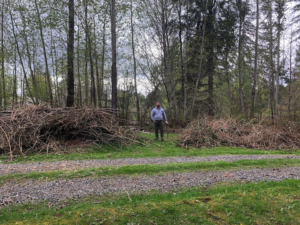NRF Executive Director Justin Hall took on an ambitious project this spring against a well-known invasive plant that gardeners and conservationists battle all over the region: Himalayan blackberry!
With the restrictions imposed by COVID-19 pandemic keeping me at home I decided it was time to tackle the Himalayan blackberry problem I had along the borders of our property. We had been keeping it at bay when it tried to grow into the yard but it was becoming increasingly difficult to mow without the blackberry reaching out and snagging clothing or skin. Our property borders Eaton Creek and so I didn’t want to use any chemicals to control the blackberry. That left me, my trusty hoe, long shirts and pants, and leather gloves to take on the bramble of canes and thorns that was taking over the trees and grasses along the edges of our property.
Himalayan Blackberry, Rubus armeniacus, is a member of the Rose family of plants (Rosaceae). It was introduced to the Pacific Northwest by Luther Burbank who sold the seeds though his catalog. Luther Burbank has an interesting and eventually troubling history, but one of his legacies is that his introduced Blackberry has become invasive.
If you’ve ever come across a patch of Himalayan Blackberry, perhaps to gather some berries, you’ll know that they are an impenetrable mass of thorns and canes. Individual canes can grow up to 40 feet long and will climb adjacent shrubs and trees. They will out-compete native vegetation, can make areas inaccessible to wildlife, especially water sources, and cause problems for people who are out enjoying nature.
Controlling them is difficult. Methods include mowing, herbicides, livestock grazing (goats!), and digging. I decided to try and dig out them out and worked on the roots with my hoe while pulling the canes out of the thickets, trees, and shrubs that they were growing in and on. Getting all the roots out is nigh on impossible but I got out what I could. Several days and many scratches on arms and legs later, my property is finally Himalayan Blackberry free.

I have a plan to check in on the areas that were infested every couple weeks to remove any new canes that shoot up. Having a plan is important. Even if you don’t get all the roots, you can kill blackberry by removing its top growth regularly, though it may take several years of vigilance. I’ll also be looking for new areas of trouble. The berries are tasty and the birds can sometimes accidentally plant them though their droppings.
I’m happy to again have access to areas that had been invaded, especially along Eaton Creek. Next I’ll take my new expertise to help in natural areas in the Nisqually Watershed, most likely with the Nisqually Land Trust, once we are able to get out and volunteer again.
The Strange, Twisted Story Behind Seattle’s Blackberries: https://www.npr.org/sections/thesalt/2016/08/29/491797791/the-strange-twisted-story-behind-seattles-blackberries
Himalayan blackberry identification and control:
Resources for reporting and controlling invasive species, and cultivating native plants on local properties:



